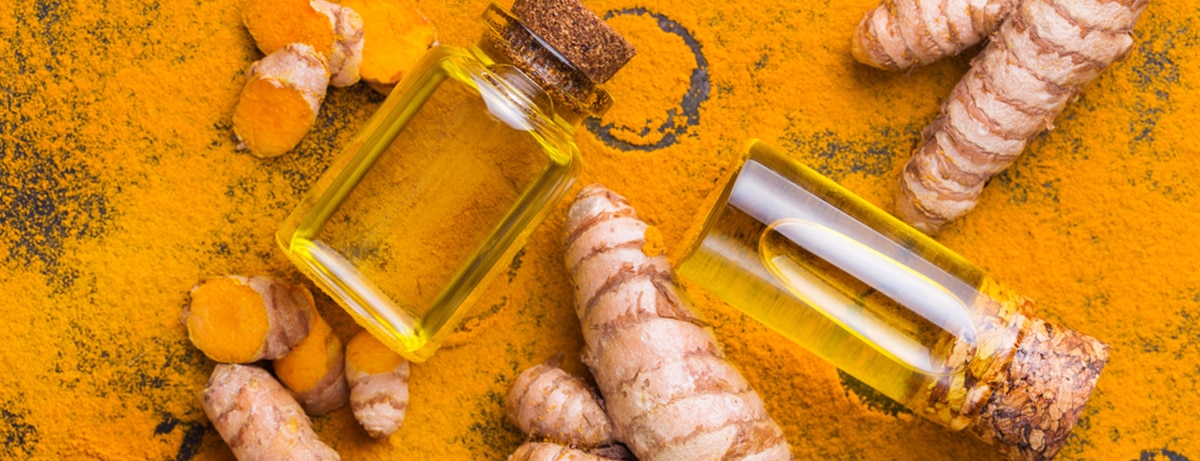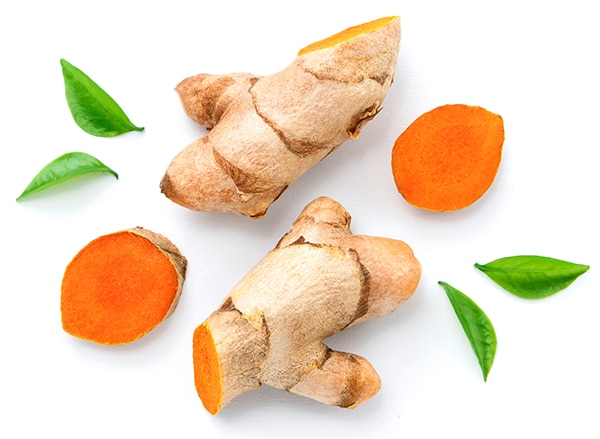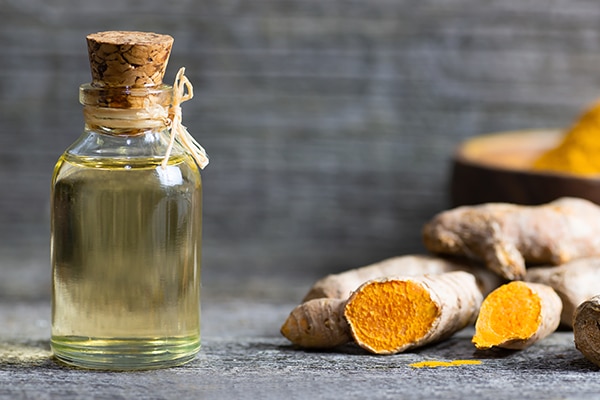15% off £40
Turmeric oil: Uses and benefits

Got ten minutes to talk turmeric? Well, we say ten minutes, but there’s actually so much good stuff to know about turmeric oil that we could easily fill ten hours.
This article’s designed to provide you with a whistle-stop tour around the world of turmeric essential oil, starting with a bit about where it comes from…
Turmeric powder is made from the root of the Curcuma Zedoaria ginger plant, which is native to Southeast Asia. The rhizomes (roots) are dried to create the bright orange-yellow turmeric powder.1 It’s actually the active ingredient, curcumin, which gives turmeric its vivid colour and soothing properties.2
How is it made?
As with most essential oils, turmeric oil is extracted from the roots of the ginger tree, using steam distillation.3
How long have people been using turmeric oil for?
Turmeric has a long old history. It’s believed that turmeric plants have been used for around 4,000 years ago, as a medicinal substance and spiritual and ceremonial object.4 It’s also been used in India for thousands of years as a spice and medicinal herb.5 In fact, it’s often used in curries and is responsible for giving curry dishes their bright yellow colour.6 Meanwhile, the use of turmeric in Ayurvedic medicine dates back to 500 BC.7


Turmeric essential oil uses
There’s so much you can do with turmeric oil. You can:
Massage it
Dilute 5 drops of turmeric oil with 10ml of Miaroma base oil and gently massage into the skin.8 When massaged, it’s believed to support the body’s natural recovery process and help with skin elasticity and firmness.9
Bathe in it
Run a warm bath and add 4 to 6 drops of turmeric oil. Then relax in the bath for at least 10 minutes to allow the aroma to work.10
Inhale it
Breathe it in directly from the bottle or sprinkle a couple of drops of it on to a cloth or tissue and gently sniff it. The warm, earthy scent is said to help uplift, energise, comfort and strengthen the body and mind.11
Apply it
As a face mask and then wash it off (as it can stain your skin). Combine mix 2 to 3 drops of turmeric oil with a carrier oil, such as tamanu oil.12 You can also apply it to cracked heels to help soften the skin. Soak your feet in warm water for 10 to 15 minutes and dry them off. Then rub a mixture of 2 to 3 drops of turmeric oil and a carrier oil, such as castor oil, to your heels, ideally once a week.13
Turmeric oil benefits
Turmeric oil has antibacterial and antifungal qualities.14 As a result, there are lots of benefits to using it, including these five:
- Soothe acne – a mixture of turmeric oil for skin and coconut, olive, jojoba or apricot oil (carrier oils) can help dry pimples out and prevent further breakouts due to its anti-fungal, antiseptic, antibacterial and soothing properties.15,16
- Reduce dandruff - massage your hair with a few drops of turmeric essential oil and then shampoo and condition as normal. The cleansing properties can reportedly help with dandruff, as well as promote healthy hair growth.17,18
- Ease sunburn – according to a study in the Journal of Cosmetic Dermatology, turmeric has photoprotective properties that can help with skin hydration and sebum production.19 Try adding 30 drops of turmeric oil to a 250ml jar of aloe vera gel and mixing before applying to the affected area.20
- Ease inflammation - turmeric essential oil's active compounds have been known to reduce the feeling of inflammation.21
How to use it safely
Always do a patch test to it make sure it doesn’t irritate your skin and always dilute it first with a carrier oil before putting it on your skin. Make sure you follow the manufacturer’s guidelines on how to use it.
Some interesting facts about turmeric
- In the Ayurvedic world, there are more than 100 different names for turmeric. They include ‘jayanti’, which means one who is victorious over diseases and ‘matrimanika’ - beautiful as moonlight22
- Turmeric can lighten pigmentation – it’s the curcumin that’s believed to be able to do this2


- https://www.newdirectionsaromatics.com/blog/products/more-than-a-powdered-spice-benefits-uses-of-turmeric-oil.html
- https://www.byrdie.com/the-surprising-skincare-benefits-of-turmeric-2442900
- https://www.newdirectionsaromatics.com/blog/products/more-than-a-powdered-spice-benefits-uses-of-turmeric-oil.html
- https://www.newdirectionsaromatics.com/blog/products/more-than-a-powdered-spice-benefits-uses-of-turmeric-oil.html
- https://www.healthline.com/nutrition/top-10-evidence-based-health-benefits-of-turmeric#section1
- https://www.precisionnutrition.com/encyclopedia/food/turmeric#:~:text=Turmeric%20is%20a%20bright%20yellow,curry%20its%20bright%20yellow%20color.
- https://www.pbs.org/food/the-history-kitchen/turmeric-history/
- /shop/product/miaroma-turmeric-pure-essential-oil-60017136?skuid=017136
- https://www.newdirectionsaromatics.com/blog/products/more-than-a-powdered-spice-benefits-uses-of-turmeric-oil.html
- /shop/product/miaroma-turmeric-pure-essential-oil-60017136?skuid=017136
- https://www.newdirectionsaromatics.com/blog/products/more-than-a-powdered-spice-benefits-uses-of-turmeric-oil.html
- https://upnature.com/blogs/news/top-15-incredible-benefits-of-turmeric-essential-oil
- https://upnature.com/blogs/news/top-15-incredible-benefits-of-turmeric-essential-oil
- https://upnature.com/blogs/news/top-15-incredible-benefits-of-turmeric-essential-oil
- https://www.india.com/lifestyle/beauty-benefits-of-turmeric-essential-oil-8-ways-to-use-turmeric-essential-oil-in-your-skincare-and-haircare-regimen-2004168/
- https://www.baseformula.com/blog/benefits-of-turmeric-essential-oil
- https://www.india.com/lifestyle/beauty-benefits-of-turmeric-essential-oil-8-ways-to-use-turmeric-essential-oil-in-your-skincare-and-haircare-regimen-2004168/
- https://www.baseformula.com/blog/benefits-of-turmeric-essential-oil
- https://upnature.com/blogs/news/top-15-incredible-benefits-of-turmeric-essential-oil
- https://www.baseformula.com/blog/benefits-of-turmeric-essential-oil
- https://upnature.com/blogs/news/top-15-incredible-benefits-of-turmeric-essential-oil
- https://www.pbs.org/food/the-history-kitchen/turmeric-history/
- https://www.byrdie.com/the-surprising-skincare-benefits-of-turmeric-2442900













